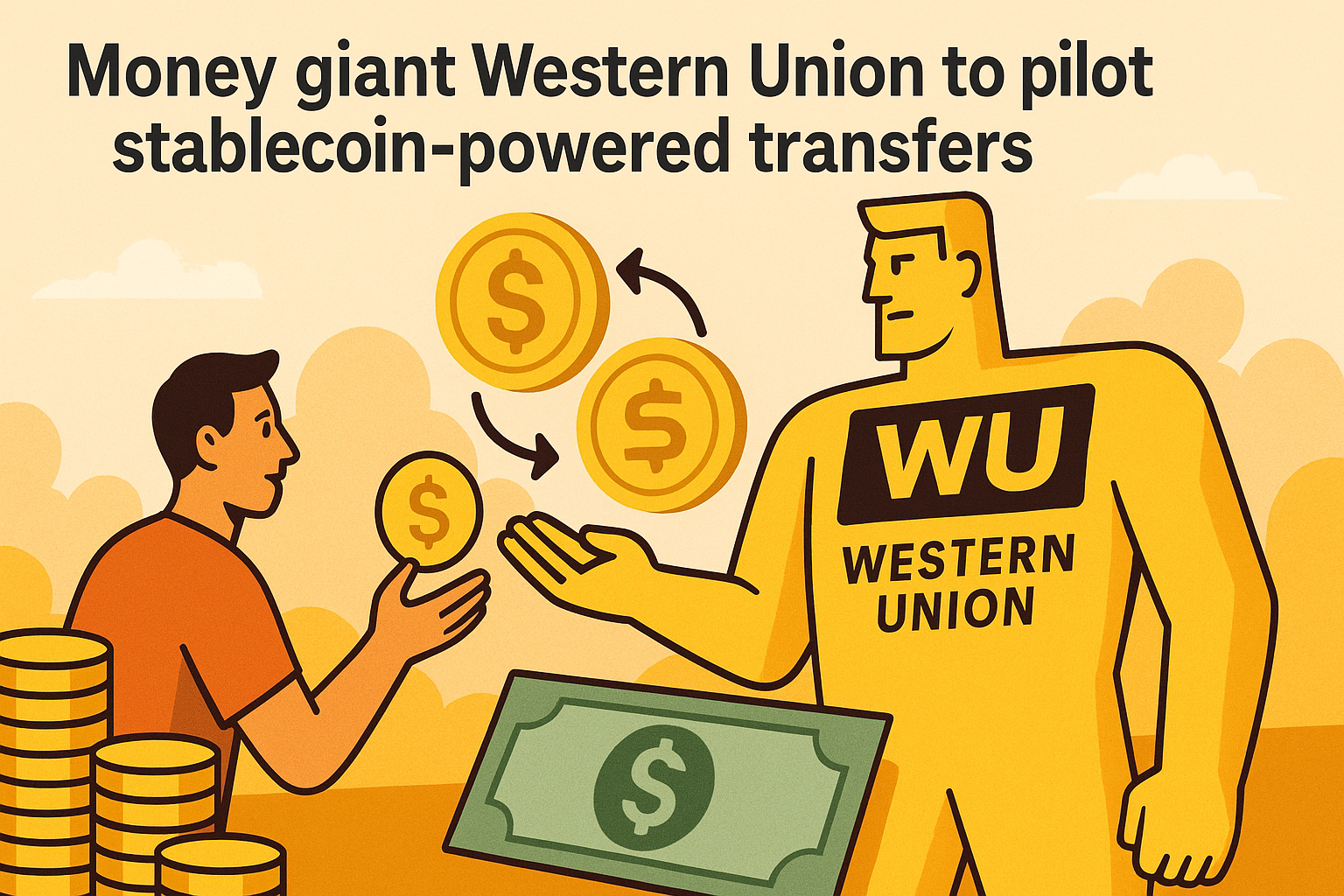The Old Guard Enters the Stablecoin Arena
For years, the traditional financial sector has cautiously observed the meteoric rise of blockchain technology from the sidelines. Many legacy institutions were skeptical or slow to adopt decentralized innovations, held back by regulatory ambiguity, technological unfamiliarity, and a reluctance to disrupt their existing revenue streams. However, times are changing. A new wave of adoption is upon us, and some of the most established financial giants are beginning to embrace blockchain’s promise. One of the most noteworthy players is Western Union, a global leader in the remittance industry, which recently announced its plans to pilot stablecoin-driven cross-border payments.
Western Union’s move is more than a knee-jerk response to market trends; it’s a calculated step into the future of fintech. The company’s pilot will harness blockchain to facilitate faster, cheaper, and more transparent transactions — a stark contrast to the slow, fee-laden system the global remittance sector has relied on for decades. For seasoned crypto investors, this transition represents a profound validation of digital assets. It symbolizes the escalating convergence between decentralized finance (DeFi) and traditional finance (TradFi) — a dynamic fusion creating immense investment possibilities.
What Are Stablecoins — And Why Do They Matter?
Stablecoins are digital assets that are typically pegged to a fiat currency — such as the U.S. dollar — or commodities like gold. This peg is designed to mitigate volatility, making stablecoins unique within the cryptocurrency ecosystem. Leading examples include USDC (USD Coin), USDT (Tether), and decentralized options like DAI. Because of their consistent value, stablecoins function as a bridge between traditional banking systems and the emerging blockchain-based economy.
The real utility of stablecoins lies in their capability to facilitate seamless, instant, and low-cost financial transactions globally. They present an alternative to the traditional financial infrastructure, which is often hampered by intermediaries, delays, and high fees. This is especially revolutionary in the cross-border remittance industry, where fees can eat up as much as 10% of each transfer. By integrating stablecoins, Western Union stands to slash these costs while increasing the speed and efficiency of its services. The result? A better user experience, reduced operational overhead, and pioneering leadership in adopting blockchain innovation.
The Groundbreaking Advantages of Stablecoin Transfers
Transitioning from fiat-based rails to stablecoin-integrated systems enables financial institutions like Western Union to tap into a host of game-changing benefits. These include:
- Lower transaction costs: Blockchain removes the need for multiple intermediaries such as correspondent banks, significantly reducing fees and increasing profit margins.
- Faster settlements: Traditional cross-border transfers can take several business days. Stablecoins, on the other hand, enable transactions that settle in seconds or minutes — even outside traditional banking hours.
- Increased transparency: Public blockchains provide a transparent audit trail, allowing for real-time verification of every transaction — reducing the risk of fraud and errors.
- Enhanced global accessibility: Stablecoin rails are available 24/7, breaking down geographical and operational barriers, and enabling financial inclusion for unbanked and underbanked populations worldwide.
For blockchain networks powering these stablecoins — such as Stellar (XLM), Ethereum (ETH), or even emerging chains like Avalanche (AVAX) — Western Union’s move could catalyze increased usage, developer interest, and capital flow, potentially spurring new highs in token valuation and user adoption.
Traditional Transfers vs. Blockchain Transfers
The conventional financial system, especially when it comes to international wire transfers, is riddled with inefficiencies. Processing times can extend over several days. Transactions are subject to banking hours, weekends, and even public holidays. Moreover, users are often hit with hidden and overt fees from a chain of intermediaries — correspondent banks, SWIFT messaging fees, currency conversion charges, and compliance-related costs.
Contrastingly, blockchain-based stablecoin transfers bypass these limitations. A remittance can be sent from New York to Nairobi or from London to Lagos in real time, often for a fraction of the cost. With stablecoins, there’s no need to convert currencies manually, no cross-border regulatory maze, and no long queues at transfer agents. They create a unified global financial ecosystem, operating 24/7, 365 days a year. Users retain more value, and financial service companies gain efficiency.
Such upgrades are not cosmetic — they’re foundational. As global remittance volumes surpass $650 billion annually, the potential for cost reduction and efficiency via stablecoins is nothing short of revolutionary. And Western Union’s adoption not only enhances its competitiveness but also places additional pressure on outdated systems to modernize or risk obsolescence.
Western Union’s Pilot Program: A Bootstrap Moment for Stablecoins
According to reports, Western Union’s pilot project will utilize the Stellar blockchain in tandem with USDC — one of the most reputable fiat-backed stablecoins issued by Circle. Stellar’s infrastructure is optimized for cross-border payments, already supporting similar programs in countries like the Philippines and Argentina. Meanwhile, USDC has gained the favor of regulators and financial institutions due to its transparency, full dollar reserves, and regular attestations.
This partnership strategically positions both Stellar and USDC at the center of mainstream adoption. Should the pilot yield positive outcomes — which seems likely given the tested nature of Stellar’s technology — it could open the floodgates. Not only would Western Union roll out stablecoin-based processing on a larger scale, but the industry at large could follow suit. Expect to see banks, neobanks, and fintech startups integrate Stellar or similar blockchain solutions, further escalating the network effect.
For investors, these developments present opportunities to capitalize on fundamental infrastructure growth. Tokens tied to Layer-1 chains that facilitate banking and remittance solutions — such as Stellar (XLM), Algorand (ALGO), and Cosmos (ATOM) — stand to see significant inflows and demand spikes.
Implications of Financial Giant Adoption
Western Union, with its global footprint and brand reputation, serves as a bellwether for institutional adoption of blockchain technology. Should this stablecoin strategy succeed, other financial giants — including Visa, Mastercard, and central banks — could be prompted to expedite their own cryptocurrency initiatives. What was previously regarded as a fringe innovation is now being evaluated for its role in reinventing structured finance.
Moreover, such moves could spur regulatory momentum. Governments and financial authorities — seeing the tangible benefits of stablecoin usage — may prioritize legal frameworks to govern such assets. Initiatives like Europe’s Markets in Crypto Assets (MiCA) and U.S. stablecoin legislation signal positive movement in this area. Regulatory clarity, in turn, could unlock institutional interest that has remained dormant due to compliance uncertainty.
For contrarian investors, this is a scenario in which early conviction pays off. The thesis that blockchain would one day become indispensable to global finance is materializing. Forward-thinking adoption by firms like Western Union could ultimately lead to broader DeFi integrations, atomic swaps, and self-custody wallets — all of which will shape the future of finance.
Investor Takeaway: How to Ride the Stablecoin Wave
The adoption curve is bending at an accelerated rate, but there’s still time to gain first-mover advantage. Here’s how investors can position themselves:
- Allocate to Infrastructure Layer Assets: Projects like Stellar (XLM), Cosmos (ATOM), Algorand (ALGO), Avalanche (AVAX), and Polygon (MATIC) form the technical foundation for stablecoin issuance and functionality. Investing in these tokens is akin to owning the railroads during the industrial boom.
- Explore Yield Opportunities in DeFi: As fiat inflows through stablecoins grow, DeFi platforms offering stablecoin liquidity pools, lending, and borrowing stand to see revenue increases. Look for platforms with a strong track record in stablecoin liquidity — including Aave, Compound, and Curve Finance.
- Track Global Regulatory Movements: Changes in international regulations directly impact the viability and velocity of stablecoin growth. Monitor developments in major economies, particularly in the EU, U.S., and Southeast Asia.
- Consider Dollar-Backed vs. Algorithmic Models: Not all stablecoins are created equal. Dollar-collateralized stablecoins like USDC and USDT are generally more stable and favorable under regulation than algorithmic models like UST (which failed dramatically). Evaluate the collateral structure before investing or allocating funds.
While the hype often revolves around volatile tokens and meme coins, stablecoins operate quietly but powerfully in the background — facilitating real economic value and institutional transformation. As adoption grows, so do opportunities for intelligent, long-term investors who understand this strategic shift.
Conclusion
The integration of stablecoins into Western Union’s core operations marks a watershed moment in the intersection of cryptocurrency and traditional
























































